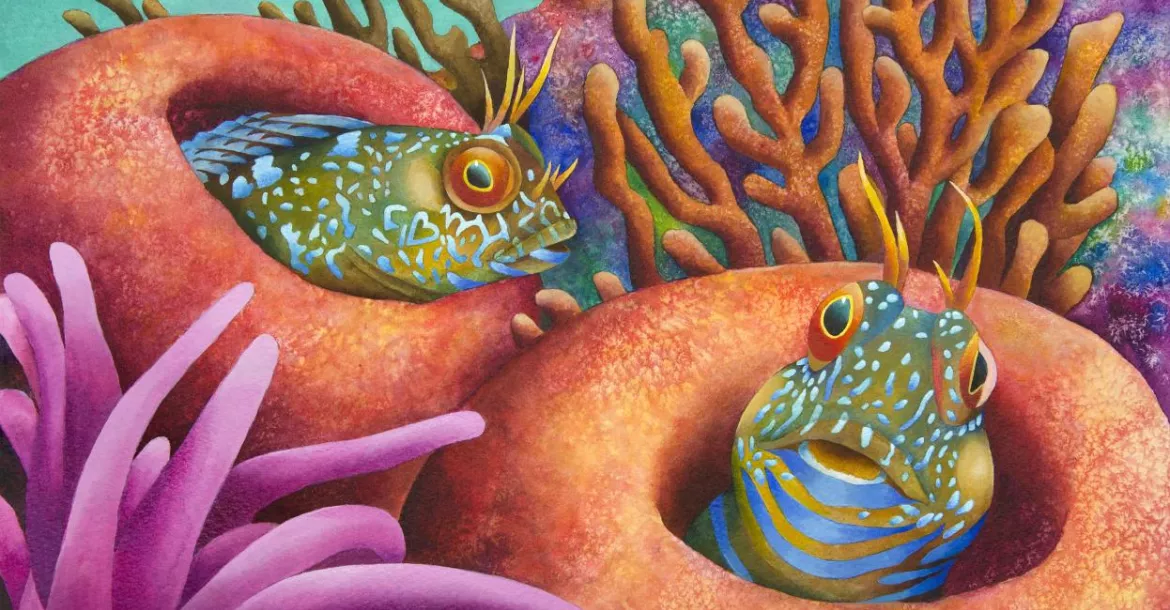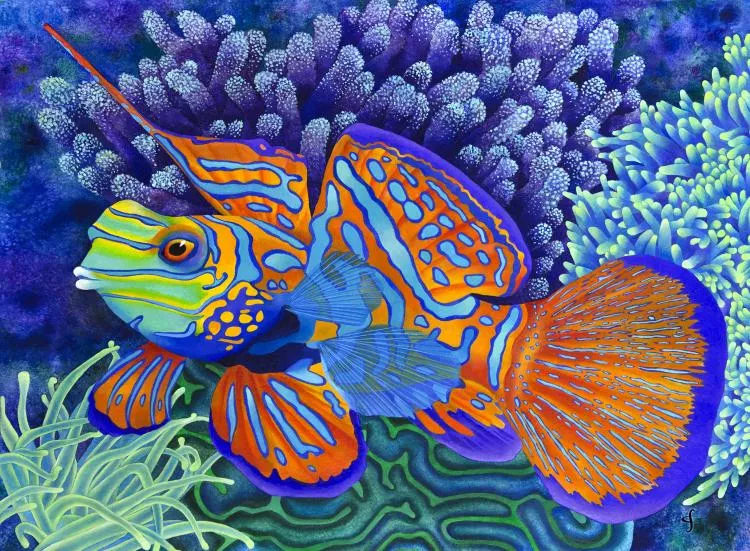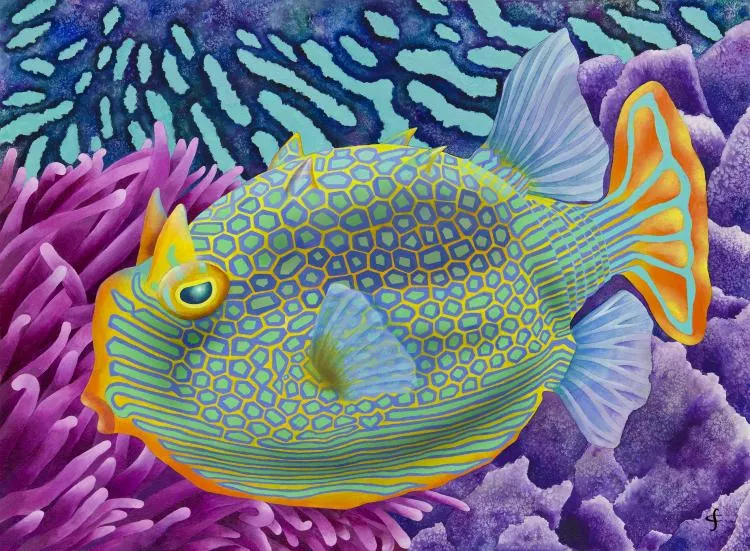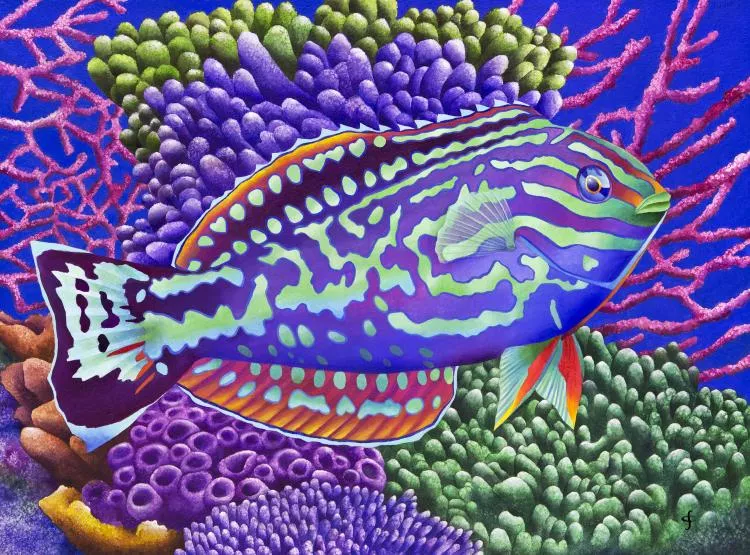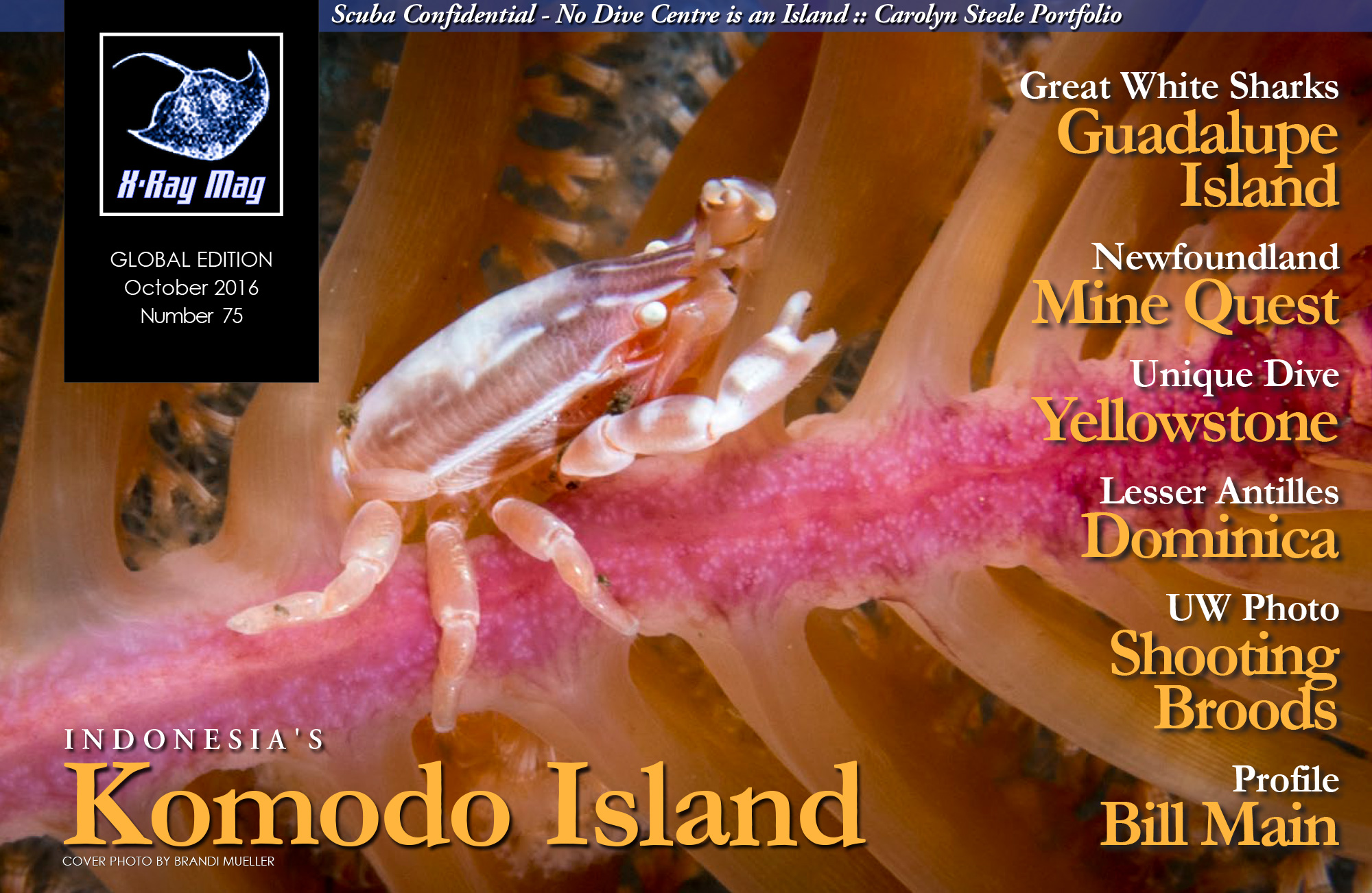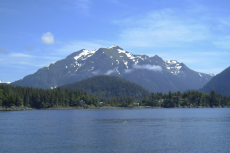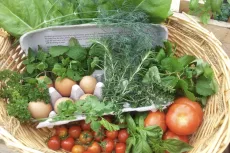Originally from England, tropical wildlife artist Carolyn Steele creates brilliant, captivating and vibrant paintings of reef life, inspired by her treks to islands in the Caribbean. Now based in the US state of Florida, the artist shares her love of the underwater world and her perspectives on ocean and reef conservation.
Contributed by
X-RAY MAG: Tell us about yourself, your background and how you became an artist.
CS: I grew up in England. As a young girl I attended private art classes where I created detailed wildlife studies in various media. My father, an incredibly talented artist, inspired and encouraged me from the time I first began drawing as a toddler.
After earning my degree in English Literature from the University of Kent at Canterbury in the UK, I embarked on a career in graphic design, just before home computers came on the scene. I made the transition from ruling pens and T-squares to computer screens, but found the computer limiting and impersonal; I preferred paintbrush and paper to mouse and mouse pad. Around the time I was feeling a bit frustrated with graphic design, I visited St. John in the US Virgin Islands (USVI) where I snorkeled among coral reefs and turquoise waters teeming with life. Everything changed after that first trip to the tropics. I came back inspired, dreaming in Technicolor, and began to capture some of my exotic Caribbean experiences on paper.
After a few years of painting Caribbean scenes and returning to Saint John with small reproductions and notecards of my work, an artist’s representative who lived in St. Thomas, USVI, contacted me and asked if he could represent me in the Virgin Islands. This was the springboard I needed to cut back on my graphic design business and focus on creating a diverse body of artwork.
X-RAY MAG: Why marine life and underwater themes? How did you come to these themes and how did you develop your style of painting?
CS: I am a snorkaholic. The very first time I put on a mask and experienced the magical underwater world of the reefs, I was hooked, forever. It was the experience of snorkeling that opened my eyes to the amazing diversity of life on our beautiful planet. I’m constantly inspired by the color, design and beauty of the wildlife I have observed over years of travel in the tropics. I was so inspired by my first visit to St. John that I began painting as a way to stay connected to the experience and extend the afterglow of what I felt had been a life-altering experience.
X-RAY MAG: What is your artistic method or creative process?
CS: I am constantly inspired by what I experience firsthand and see in various media. My husband, also an artist, has photographed extensively on our snorkeling trips. I use his photographs, and those in books and online, both as references and creative springboards. In graphic design, I had been constrained in my use of color, especially if a client’s print job was just a one-color or two-color project. I found painting to be incredibly liberating. I like to work fairly big, rarely smaller than 18” x 24” (46 x 61cm); I do most of my paintings on 22” x 30” (56 x 76cm) heavy 300 lb. cold-press watercolor paper.
I generally go into a ‘zone’ where I open my mind to ideas. I love to use humor in my work. Often a title will pop into my head, from which a scene will emerge. Once an idea takes hold and the main elements are in mind, I compose a tight sketch, which I then enlarge and transfer to watercolor paper. The next step is to apply gesso, then masking fluid, to protect parts of the drawing before applying background washes—which is when the fun begins.
My paintings take between 20 and 80 hours to complete, which means I live in each scene for quite a while. My technique is tight and my compositions are carefully thought out, but not everything is predictable. I have lots of fun with blends, staining and salting. Acrylic paints suit my style because they enable me to layer colors and build highlights.
X-RAY MAG: What is your relationship to the underwater world and coral reefs? As a snorkeler, how have your experiences underwater influenced your art? In your relationship with reefs and the sea, where have you had your favorite experiences?
CS: We have snorkeled extensively in the US and British Virgin Islands, Carriacou, the Tobago Cays, Bonaire and the Florida Keys. My favorite experiences have been in St. John, USVI, where approximately 60 percent of the island is designated a US National Park. I have so many “favorite experiences” that it’s hard to narrow them down.
My most spiritual moments have been while swimming among large sea turtles. To watch them quietly and gain their trust enough view them close up is pure magic. Most of my paintings contain one or more of these beautiful creatures.
I also enjoy what I call “micro-snorkeling.” Shallow fringing reefs right off the beach are best for this. Watching cleaner shrimp grooming fish, feather duster worms responding to the current, tiny blennies peeking out of their hidey-holes—it’s all enchanting. Sea life in this shallow, light-filled environment is about as colorful and exotic as anything on the planet.
Some friends once took us in their sailboat to a secret mangrove cove. It’s hard to describe how vivid and mysterious it was, but my husband posted a video on YouTube, called “St. John: A Snorkeler’s Paradise,” which conveys the essence of that adventure.
Mangroves are nurseries for sea life. It was fascinating to see the huge variety of juvenile fish swimming through shafts of sunlight among the mangrove roots, many of which were beautifully encrusted with colorful coral and sponges, or see them lurking in eerie shadows to avoid detection. A snorkeling expedition to a mangrove should be on every diver’s bucket list.
X-RAY MAG: What are your thoughts on ocean conservation and coral reef management and how does your artwork relate to these issues?
CS: I’m committed to nature education and conservation, which is why I donate a portion of my profits to wildlife and reef conservation groups. I hope my artwork will help people appreciate the variety and fragility of the reef biosystem. Many species represented in my paintings, such as sea turtles, are threatened or endangered.
I have seen an alarming degradation of the reefs we have visited over the past 25 years—due to careless tourists and boaters, pollution from property development runoff, storm damage, cruise ships, and ocean temperature and acidity changes. We must work to reverse this trend. I hate to think that future generations might only be able to appreciate the ocean’s diversity of life through the paintings, photographs and videos people are making today.
X-RAY MAG: What is the message or experience you want viewers of your artwork to have or understand?
CS: My painting, “Handle With Care,” probably says it best. It’s up to us human beings, as the most successful life form on Earth, to cherish and protect our planet. Don’t take things for granted. Be curious but careful. Have respect for other life forms, some of which have been around for millennia and are suddenly endangered because of our recklessness, selfishness and short sightedness. As the old saying goes, leave behind only footprints.
X-RAY MAG: What are the challenges and/or benefits of being an artist in the world today?
CS: In many ways, we artists have a great deal more control over our product today in that we can reproduce our artwork affordably. A few years ago, I invested in a large format Epson printer. This enables me to produce my cards and prints on demand, using archival inks on high quality paper or canvas in a variety of sizes to suit any buyer’s budget—instead of having to make a huge up-front investment to print limited runs of artwork, as with the lithography printing process.
We artists also have greater quality control now because of digital cameras and the ability to color correct or manipulate our own images once they have been digitized. It means I can finish a painting one day and feature it on my website (CarolynSteele.com) or my Etsy shop (Etsy.com/shop/WaterlemonMoon) the next.
X-RAY MAG: How do people respond to your works? What feedback or insights have you gained from the process of showing your work to various audiences?
CS: I have had great feedback on my work from people all over the world. Many are divers who say the images remind them of special times spent on the reef. Others say that my images simply make them feel happy.
It is always exciting to see children react to my artwork. Thanks to my licensing company (MGL Licensing in London), my images can be seen worldwide on posters, puzzles, tile murals, fabrics and other media. A few months ago at an art festival, a little girl stopped in front of one of my prints and said, “I have a puzzle of that one!”
I find that kids are initially drawn to my work because of the colors, and then get hooked on the subject matter. They will often ask me questions about the species I paint. I like to think these are future snorkelers and divers... and conservationists.
X-RAY MAG: What are your upcoming projects, art courses or events?
CS: I always have a few paintings waiting in the pipeline. I’m just finishing up a big piece and have two smaller ones sketched out already. My husband and I recently moved to southwest Florida, and will be participating in art festivals down here during the upcoming high season (October through April).
X-RAY MAG: Any last thoughts to leave with our readers about your art?
CS: I see my paintings as love letters to the tropics. I hope they inspire people to go out and experience, and cherish, these amazing sights in real life. ■
For more information, please visit the artist’s website at: CarolynSteele.com.
It’s up to us human beings, as the most successful life form on Earth, to cherish and protect our planet. Don’t take things for granted... Have respect for other life forms, some of which have been around for millennia and are suddenly endangered because of our recklessness, selfishness and short sightedness.
— Carolyn Steele

